20 + 1 Greek sweets and desserts
I’ve always had a sweet tooth. Having grown up in Northern Greece, I’ve become an expert in (savouring) Greek sweets and desserts. In the last few years, I have often re-created those sweets and desserts from my homeland, though I am yet to become an expert in baking/making Greeks sweets and desserts.
Here are some of the most iconic Greek sweets and desserts, with links to the recipes. Some of these recipes are mine, whereas some are by Akis Petretzikis, a Greek chef that I trust and follow.
Μπουγάτσα (Bougatsa)
Bougatsa is a pie made with phyllo pastry and typically served in the morning (breakfast or brunch). It is very popular in my hometown, Thessaloniki, and in Northern Greece in general. The filling can be either sweet (custard) or savoury (cheese). After it is baked, it is cut into serving pieces and served hot. If the filling is sweet (as it often is), then the pastry is dusted with icing sugar and cinnamon. Here is the link to a recipe by Akis Petretzikis.
Τσουρέκι (Tsoureki)
Tsoureki is a sweet bread made with flour, milk, butter and sugar and commonly seasoned with orange zest, mastic and mahlab. Although it is consumed all year long, it has a strong association with Easter (quite like the hot cross buns). The main difference between the normal tsoureki and the Easter variation is that the latter comes with an egg dyed red. It can be round or rectangular and is usually consumed at room temperature, together with coffee, rather than as a dessert.
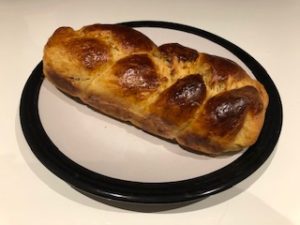
A couple of years ago, I came across a recipe by Argiro Barbarigou that uses honey instead of sugar. Since I tend to substitute sugar with honey when I bake, I thought I’d give it a go. It was not only the best tsoureki I’ve ever baked, but also the best I’ve ever eaten. For this reason, I decided not to tweak it all, not even halve the quantity, only translate it to English and share it. Here is the link to the recipe.
Σάμαλι & Ραβανί (Samali & Ravani)
Samali is a Greek cake made with semolina (instead of flour), flavoured with ground mastic, and soaked in syrup. It is very similar to another Greek cake: ravani (or revani). The main difference is that samali does not have eggs, whereas ravani does not have mastic.
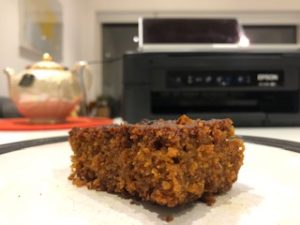
Traditionally, samali is made with semolina, sugar, yoghurt and/or oil, is flavoured with mastic and citrus fruits, and is soaked in sugar syrup. To make it healthier, I substituted the sugar with honey. I have also substituted the yoghurt with kefir. To make it vegan, this can be further substituted with coconut milk or yoghurt, or even with water. Here is the link to my recipe (for samali).
Here is the link to a recipe for ravani (by Akis Petretzikis).
Μπακλαβάς (Baklavas)
One of the most famous Greek desserts, baklava can also be found in other countries, such as neighbouring Turkey and the countries of the Levant. It belongs to a category of sweets called siropiasta (syrupy). It is a multi-layered dessert made of phyllo pastry, filled with chopped nuts (usually walnuts, but sometimes almonds or pistachios are also used). Once baked, the syrup is poured over the baklava and allowed to soak in. The Greek baklava tends to be sweeter and wetter than the more oriental versions. Here is the link to a recipe by Akis Petretzikis.
Χαλβάς (Halvas)
The word ‘halva’ (‘halvas’ in Greek) is used to describe two different types of desserts: a semolina-based one (usually round in shape) and a tahini-based one (usually rectangular in shape). The latter is called ‘Makedonikos halvas’ (Macedonian halva). I prefer the former.
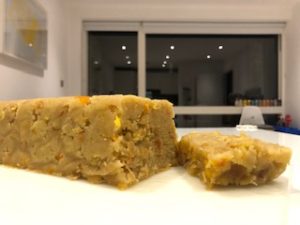
Traditionally, the recipe calls for 4 main ingredients: oil, semolina, sugar and water. In fact, it is pretty easy to remember the amounts of each ingredient: 1 cup oil, 2 cups semolina, 3 cups sugar and 4 cups water. However, as I’m in the habit of substituting sugar in my recipes, I use honey instead (only 2 cups, as it tends to be sweeter than sugar). I also add a whole orange for flavour, as well as aromatic spices (cinnamon and cloves) and flaked almonds. Here is the link to my recipe.
Εκμέκ καταϊφι (Ekmek kataifi)
Ekmek kataifi is another rich dessert popular in Greece as well as in Turkey (as the name suggests). It is made with layers of kataifi dough baked then drizzled with syrup, topped with custard and whipped cream, and garnished with pistachios. Here is the link to a recipe by Akis Petretzikis.
Καζάν Ντιμπί (Kazan Dibi)
This is another dessert of Turkish origin, hence the Turkish name. It is particularly popular in Thessaloniki, where it is served at the end of a meal. It is made with milk, cream, cornstarch and sugar and is flavoured with vanilla and mastic. The top layer is caramelised. Overall, kazan dibi is similar to crema Catalana and crème brulee. However, unlike these Western European desserts, it is baked in a baking tray (rather than individual ramekins) and does not contain egg yolks. Here is the link to a recipe by Akis Petretzikis.
Πορτοκαλόπιτα (Portokalopita)
When I visited the island of Amorgos a few summers ago, I came across Kallisto, an inviting little café-patisserie. I had a slice of portokalopita (orange pie), indulgently served with vanilla ice cream. It was simply one of the best Greek sweets and/or desserts I’ve ever had.
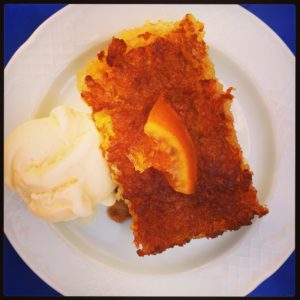
Returning home, I set to re-create Kallisto’s portokalopita. A quick Google search brought me across a number of slightly different recipes and one question: which one should I choose? Some used Greek yoghurt, others milk or cream; the number of eggs varied between three and five and so did the number of oranges. Despite their differences, however, there was one thing that all these recipes had in common: they all used phyllo pastry. In the end, I decided to tweak Vefa Alexiadou’s recipe, swapping the yoghurt with kefir.
The end result was as fragrant and moist as Kallisto’s and it took me back to Amorgos. My colleagues also enjoyed it to the extent that I had to later hand out copies of the recipe. Here is the link to my recipe.
Φανουρόπιτα (Fanouropita)
Let’s now leave Amorgos and the Cyclades and go to Rhodes and the Dodecanese. Saint Fanourios, the patron saint of Rhodes, is commemorated on 27 August. Fanourios means the one who reveals (fanerono means reveal in Greek), and according to the tradition, Saint Fanourios helps people find their lost belongings or even missing persons. In Rhodes and other places in Greece and Cyprus, believers bake a cake called fanouropita on 26 August; then, the following day, they take it to the church where it is blessed and then offered to more believers. Despite its name, fanouropita is not a pie (pita means pie in Greek), but a fasting cake made with 7, 9, or 11 ingredients (always an odd number).
When I baked my own fanouropita a few years ago, I replaced the sugar -traditionally used- with honey, and also skipped the final step of sprinting icing sugar over the baked cake. Here is the link to my recipe.
Καρυδόπιτα (Karidopita)
Karidopita means walnut pie in Greek, but, like fanouropita, it is more like a cake than a pie. Unlike fanouropita, however, karidopita is a syrupy cake; once baked, it is drizzled with syrup. Here is the link to a recipe by Akis Petretzikis.
Γαλακτομπούρεκο (Galaktouboureko)
Galaktoboureko is made of custard baked in phyllo. Like samali, ravani, baklava and karidopita, It is baked in a large baking tray and, once out of the oven, it is drizzled with a generous amount of syrup. Here is the link to a recipe by Akis Petretzikis.
Τρίγωνα (Trigona)
Trigona are similar to galaktoboureko but triangular in shape (trigona means triangles in Greek). They are basically cones made of phyllo pastry, baked, dipped in syrup and then filled with custard (unlike galaktoboureko, where the custard is baked). They originate from Panorama, a Thessaloniki suburb, and for this reason are often called Trigona Panoramatos. Here is the link to a recipe by Akis Petretzikis.
Λουκουμάδες (Loukoumades)
Also known as Greek doughnuts, loukoumades (not to be confused with loukoumia), are also deep-fried, but ball-shaped and smaller in size than American doughnuts. They are typically served in a dish at the end of a meal, drizzled with syrup and sprinkled with chopped walnuts and cinnamon. Alternative toppings include tahini and chocolate sauce. Here is the link to a recipe by Akis Petretzikis.
Λουκούμια (Loukoumia)
Known as Turkish delight in English, loukoumia are bite-sized cubes, made with starch, sugar and gelatine. They are usually flavoured with rose, bergamot, or mastic, which give them different colours. They are typically served along with coffee. Here is the link to a recipe by Akis Petretzikis.
Γλυκά του κουταλιού (Glyka tou koutaliou)
Glyka you koutaliou (spoon sweets) are traditional desserts that can be made from most fruit, such as citrus fruits, cherries, figs, or quinces. In the past, the fruit was preserved in sugar syrup to prolong its season, and this is how spoon sweets were born. Nowadays, they remain a popular dessert, usually served in a teaspoon on a small crystal or porcelain plate, along with a glass of water and/or coffee, as a welcome gesture. A spoon sweet is made with only one type of fruit, although you can also find spoon sweets made with nuts or roses (instead of fruit). A spoon sweet made with tomatoes (technically a fruit) is very popular on the island of Kos. Here is the link to a recipe by Akis Petretzikis.
Αμυγδαλωτά (Amygdalota)
Amygdalota are ball or tear-shaped, bite-sized almond biscuits, dusted with icing sugar. Named after amygdalo (almond in Greek), they are typical of the islands.
Παστέλι (Pasteli)
Pasteli is a bar made with honey and sesame. It is rather hard and sticky and is usually eaten as a snack rather than a dessert. Here is the link to a recipe by Akis Petretzikis.
Greek sweets and desserts for Christmas
And since this is this time of the year…
Μελομακάρονα (Melomakarona)
One of the many things I love about Christmas is melomakarona. These aromatic cookies are made of flour and olive oil, flavoured with cinnamon, cloves and orange, and dipped in honey syrup. Since melomakarona are traditionally eaten around Christmas time, one may say they are the Greek equivalent to the British mince pies. Here is the link to my recipe.
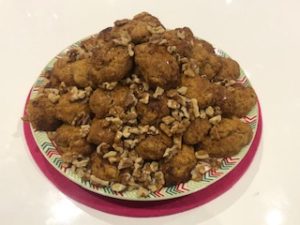
Κουραμπιέδες (Kourabiedes)
Unlike melomakarona, kourabiedes is one of my least favourite things about Christmas, as well as my least favourite item on this list. Yet, they’re very Christmassy and they look so festive that I find it hard to picture a Christmas table without them.
Kourabiedes are shortbread-type biscuits. They are typically made with almonds, are usually shaped into balls, and then baked till slightly golden. Once out of the oven, they are rolled in icing sugar while still hot, forming a rich butter-sugar coating. Here is the link to a recipe by Akis Petretzikis.
Βασιλόπιτα (Vasilopita)
Vasilopita means (Saint) Basil’s pie, but is rather a round-shaped cake very similar in texture and flavour to tsoureki. It is served on New Year’s Day (Saint Basil’s Day) and cut in slices dedicated to the people present. The person who finds the coin that has been inserted into the cake is said to have good luck for the rest of the new year.
Hope you all have a very merry Christmas and a Happy New Year!
Alex
(the Traveling Psychiatrist)